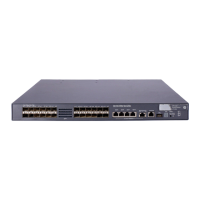18
To do… Use the command… Remarks
6. Configure the operation type.
operation { get | put }
Optional.
By default, the operation type for
the FTP is get, which means
obtaining files from the FTP server.
7. Configure a login username.
username name
Required.
By default, no login username is
configured.
8. Configure a login password.
password password
Required.
By default, no login password is
configured.
9. Specify a file to be transferred
between the FTP server and
the FTP client.
filename file-name
Required.
By default, no file is specified.
10. Set the data transmission
mode for FTP tests.
mode { active | passive }
Optional.
active by default.
11. Configure optional
parameters.
See “Configuring optional
parameters for an NQA test
group”
Optional.
NOTE:
• When you execute the put command, a file
file-name
with fixed size and content is created on the
FTP server. When you execute the get command, the device does not save the files obtained from the
FTP server.
• When you download a file that does not exist on the FTP server, FTP tests fail.
• When you execute the get command, use a file with a small size. A big file may result in test failure
due to timeout, or may affect other services for occupying too much network bandwidth.
Configuring HTTP tests
HTTP tests of an NQA test group are used to test the connection between the NQA client and an HTTP
server and the time required to obtain data from the HTTP server. HTTP tests enable you to detect the
connectivity and performance of the HTTP server.
Configuration prerequisites
Before you start HTTP tests, configure the HTTP server.
Configuring HTTP tests
To configure HTTP tests:
To do… Use the command… Remarks
1. Enter system view.
system-view —
2. Enter NQA test group view.
nqa entry admin-name operation-
tag
—
3. Configure the test type as
HTTP and enter test type view.
type http Required.

